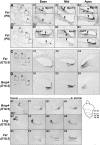Developmental gene expression profiling along the tonotopic axis of the mouse cochlea
- PMID: 22808246
- PMCID: PMC3395647
- DOI: 10.1371/journal.pone.0040735
Developmental gene expression profiling along the tonotopic axis of the mouse cochlea
Abstract
The mammalian cochlear duct is tonotopically organized such that the basal cochlea is tuned to high frequency sounds and the apical cochlea to low frequency sounds. In an effort to understand how this tonotopic organization is established, we searched for genes that are differentially expressed along the tonotopic axis during neonatal development. Cochlear tissues dissected from P0 and P8 mice were divided into three equal pieces, representing the base, middle and apex, and gene expression profiles were determined using the microarray technique. The gene expression profiles were grouped according to changes in expression levels along the tonotopic axis as well as changes during neonatal development. The classified groups were further analyzed by functional annotation clustering analysis to determine whether genes associated with specific biological function or processes are particularly enriched in each group. These analyses identified several candidate genes that may be involved in cochlear development and acquisition of tonotopy. We examined the expression domains for a few candidate genes in the developing mouse cochlea. Tnc (tenacin C) and Nov (nephroblastoma overexpressed gene) are expressed in the basilar membrane, with increased expression toward the apex, which may contribute to graded changes in the structure of the basilar membrane along the tonotopic axis. In addition, Fst (Follistatin), an antagonist of TGF-β/BMP signaling, is expressed in the lesser epithelial ridge and at gradually higher levels towards the apex. The graded expression pattern of Fst is established at the time of cochlear specification and maintained throughout embryonic and postnatal development, suggesting its possible role in the organization of tonotopy. Our data will provide a good resource for investigating the developmental mechanisms of the mammalian cochlea including the acquisition of tonotopy.
Conflict of interest statement
Figures





Similar articles
-
Analysis of gene expression profiles along the tonotopic map of mouse cochlea by cDNA microarrays.Acta Otolaryngol Suppl. 2009 Jun;(562):12-7. doi: 10.1080/00016480902926464. Acta Otolaryngol Suppl. 2009. PMID: 19848233
-
Follistatin regulates the specification of the apical cochlea responsible for low-frequency hearing in mammals.Proc Natl Acad Sci U S A. 2023 Jan 3;120(1):e2213099120. doi: 10.1073/pnas.2213099120. Epub 2022 Dec 28. Proc Natl Acad Sci U S A. 2023. PMID: 36577057 Free PMC article.
-
3D reconstruction of the mouse cochlea from scRNA-seq data suggests morphogen-based principles in apex-to-base specification.Dev Cell. 2024 Jun 17;59(12):1538-1552.e6. doi: 10.1016/j.devcel.2024.03.028. Epub 2024 Apr 8. Dev Cell. 2024. PMID: 38593801 Free PMC article.
-
Development of tonotopy in the auditory periphery.Hear Res. 2011 Jun;276(1-2):2-15. doi: 10.1016/j.heares.2011.01.011. Epub 2011 Jan 27. Hear Res. 2011. PMID: 21276841 Review.
-
The acquisition of positional information across the radial axis of the cochlea.Dev Dyn. 2020 Mar;249(3):281-297. doi: 10.1002/dvdy.118. Epub 2019 Oct 24. Dev Dyn. 2020. PMID: 31566832 Free PMC article. Review.
Cited by
-
In vitro and in vivo models: What have we learnt about inner ear regeneration and treatment for hearing loss?Mol Cell Neurosci. 2022 May;120:103736. doi: 10.1016/j.mcn.2022.103736. Epub 2022 May 14. Mol Cell Neurosci. 2022. PMID: 35577314 Free PMC article. Review.
-
A Sox10(rtTA/+) Mouse Line Allows for Inducible Gene Expression in the Auditory and Balance Organs of the Inner Ear.J Assoc Res Otolaryngol. 2015 Jun;16(3):331-45. doi: 10.1007/s10162-015-0517-9. Epub 2015 Apr 21. J Assoc Res Otolaryngol. 2015. PMID: 25895579 Free PMC article.
-
Transcriptomic Analysis of Mouse Cochlear Supporting Cell Maturation Reveals Large-Scale Changes in Notch Responsiveness Prior to the Onset of Hearing.PLoS One. 2016 Dec 5;11(12):e0167286. doi: 10.1371/journal.pone.0167286. eCollection 2016. PLoS One. 2016. PMID: 27918591 Free PMC article.
-
The single-cell transcriptomic landscape of the topological differences in mammalian auditory receptors.Sci China Life Sci. 2024 Nov;67(11):2398-2410. doi: 10.1007/s11427-024-2672-1. Epub 2024 Jul 29. Sci China Life Sci. 2024. PMID: 39083201
-
Characterization of the transcriptome of nascent hair cells and identification of direct targets of the Atoh1 transcription factor.J Neurosci. 2015 Apr 8;35(14):5870-83. doi: 10.1523/JNEUROSCI.5083-14.2015. J Neurosci. 2015. PMID: 25855195 Free PMC article.
References
-
- Davis RL. Gradients of neurotrophins, ion channels, and tuning in the cochlea. Neuroscientist. 2003;9:311–316. - PubMed
-
- Mann ZF, Kelley MW. Development of tonotopy in the auditory periphery. Hear Res. 2011;276:2–15. - PubMed
-
- Meyer AC, Frank T, Khimich D, Hoch G, Riedel D, et al. Tuning of synapse number, structure and function in the cochlea. Nat Neurosci. 2009;12:444–453. - PubMed
Publication types
MeSH terms
Substances
Associated data
- Actions
LinkOut - more resources
Full Text Sources
Molecular Biology Databases
Miscellaneous

